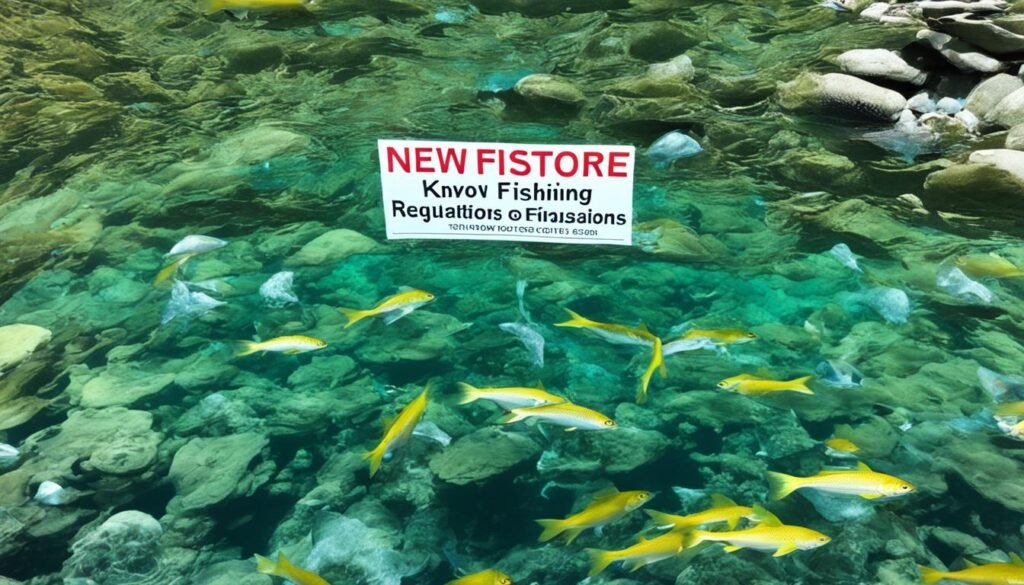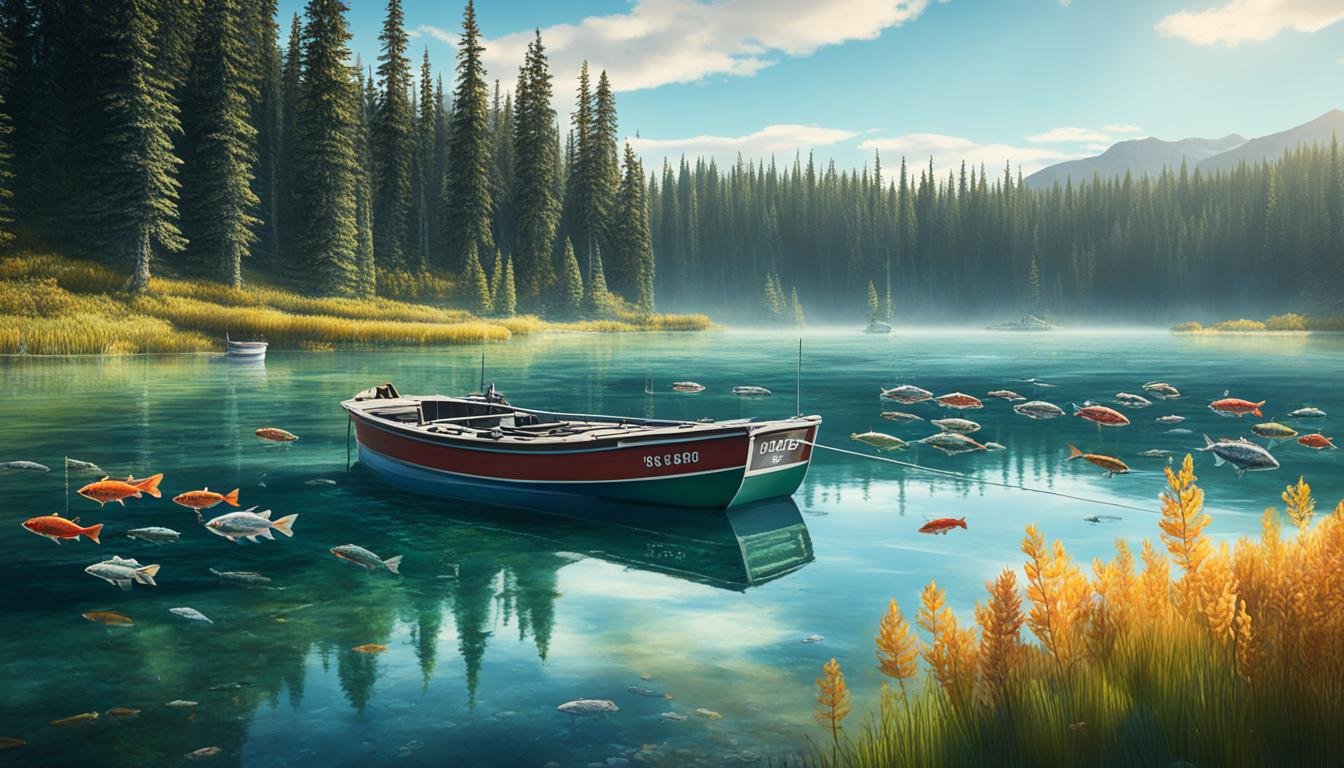Saskatchewan’s lakes, rivers, and streams attract anglers from everywhere. The 2024-25 Saskatchewan Anglers Guide helps fishers follow rules and catch limits. This guide ensures sustainable fishing practices while enjoying the sport.
The Fisheries Regulations under The Fisheries (Saskatchewan) Act, 2020, set the legal framework for fishing. These rules cover licensing, catch limits, and permitted fishing zones. They also outline specific seasons for various fishing activities.
Key Takeaways: Saskatchewan Fishing Regulations
- Fishing in Saskatchewan is regulated by The Fisheries Regulations under The Fisheries (Saskatchewan) Act, 2020.
- A valid Saskatchewan angling license is required for most individuals aged 16 and older, with exceptions for youth and seniors.
- Ice fishing rules allow for the use of up to two lines, which must be within sight and 25 meters of the angler.
- Bow fishing and spear fishing are permitted with a valid angling license, subject to the same species limits as hook-and-line angling.
- Penalties for fishing infractions can reach $100,000 in fines and up to 12 months of imprisonment, with license suspensions of one to five years for serious offenses.
Accessing the Saskatchewan Anglers Guide
The 2024-25 Saskatchewan Anglers Guide is now available digitally. It covers angling rules, fishing licenses Saskatchewan, and fishing regulations Saskatchewan. The Ministry of Environment publishes this essential guide for anglers.
Online and Digital Accessibility
Anglers can now download the Saskatchewan Anglers Guide to their devices. This ensures they have the latest regulations at their fingertips. The guide is accessible through the Ministry of Environment’s website.
Physical copies will be available in early May. You can find them at Ministry field offices, most provincial park offices, and select retail outlets. This caters to anglers who prefer printed versions.
“The digital availability of the Saskatchewan Anglers Guide has never been more important, as it allows anglers to have the latest regulations and policies at their fingertips, no matter where they are.”
The guide covers waterbodies, catch limits, and special regulations. It also includes general prohibitions and specialized fishing techniques. This helps anglers make informed decisions and follow fishing regulations.
Anglers should review the guide thoroughly to stay informed. This helps manage the province’s fisheries responsibly. The Ministry makes it easier for anglers to access this vital resource.
Key Changes and Updates

The 2022-2023 Saskatchewan Anglers Guide has new fishing rules. Anglers should check these updates before fishing. This ensures they follow the latest rules and catch limits.
Catch limits have decreased for some waters. Cold Lake, Ministikwan Lake, and Nemeiben Lake now have lower limits. A plan for 2025-26 may set largemouth bass limit to zero in Boundary Reservoir.
The guide lists waters with specific catch limits and special rules. It’s available at Environment offices, park offices, and some stores in early May. The guide details Saskatchewan’s fishing rules, policies, and practices.
| Waterbody | Previous Catch Limit | New Catch Limit |
|---|---|---|
| Cold Lake | 4 | 2 |
| Ministikwan Lake | 4 | 2 |
| Nemeiben Lake | 4 | 2 |
| Boundary Reservoir (Proposed for 2025-26) | 4 | 0 |
Anglers should keep up with these fishing rule updates. Knowing the latest catch limits and new rules helps ensure compliance when fishing in Saskatchewan.
“These changes aim to protect our fisheries for the future,” said an Environment Ministry spokesperson. “We urge anglers to review the guide and learn the latest updates.”
Fishing Seasons and Saskatchewan Fishing Regulations
Saskatchewan’s fishing season opens at different times across the province’s management zones. The southern zone starts on May 5. The central zone begins on May 15. The northern zone opens on May 25.
Anglers must know the rules for their chosen fishing spot. The Saskatchewan Anglers Guide offers details on zone openings and rules. This helps anglers plan trips and follow regulations.
Zonal Openings and Regulations
Saskatchewan Fishing Regulations set limits on fish size and number for different species. For example, you can keep one Arctic grayling over 35 cm. One Channel catfish under 60 cm is allowed.
You can have one Lake trout over 65 cm. One Northern pike over 75 cm is permitted. Anglers can keep one Walleye/sauger/saugeye bigger than 55 cm.
Catch limits apply to other fish too. You can keep 25 Perch, 8 Burbot, and 8 Goldeye/mooneye. The limit is 6 Rock bass and 5 Stocked trout.
Some fish can’t be caught at all. These include Bigmouth buffalo, Smallmouth bass, and Sturgeon.
| Fish Species | Maximum Allowed | Size Limit |
|---|---|---|
| Arctic grayling | 1 | Exceeding 35 cm |
| Channel catfish | 1 | Not exceeding 60 cm |
| Lake trout | 1 | Over 65 cm |
| Northern pike | 1 | Over 75 cm |
| Walleye/sauger/saugeye | 1 | Greater than 55 cm |
Keep up with Saskatchewan Fishing Regulations. Check the official website or contact authorities for the latest info.
Angling Licenses and Indigenous Fishing Rights
In Saskatchewan, most anglers need a valid license to fish. Exceptions include those with Treaty or Aboriginal fishing rights for food. Some seniors and veterans can get free licenses.
Fishing in Saskatchewan’s boundary waters requires a valid license. Breaking these rules can lead to hefty fines or jail time.
Indigenous fishing rights apply to registered Indians from specific First Nations. They must carry a valid Certificate of Indian Status. These rights stem from various Treaties.
| Angling Licenses | Indigenous Fishing Rights |
|---|---|
| Required for anglers aged 16 and older, except for Saskatchewan resident seniors and Armed Forces veterans | Recognized for registered Indians who are members of First Nations that signed Treaties 2, 4, 5, 6, 7, 8 or 10, or First Nations located within Saskatchewan that have not signed a Treaty |
| Violations can result in fines up to $100,000 and/or imprisonment up to 12 months | Upheld by numerous landmark court decisions, including Sparrow, Gladstone, Delgamuukw, Marshall, Haida, and Ahousaht |
| Free licenses available for Saskatchewan resident seniors and Armed Forces veterans | Individuals must be registered Indians and carry a valid Certificate of Indian Status |
Saskatchewan’s fishing rules balance angler needs and Indigenous rights. These rules stem from court decisions and treaties. Understanding them helps anglers fish legally and respect Indigenous traditions.
Conclusion
The 2024-25 Saskatchewan Anglers Guide sums up fishing rules in the province. Anglers should check it for catch limits and seasonal openings. By following these rules, we help keep fish populations healthy.
The Fisheries Act manages fisheries and protects fish habitats. It’s been changed 17 times since 1868. The federal government oversees fisheries as per the Constitution Act, 1867.
The Fisheries (Saskatchewan) Act of 2020 sets out provincial rules. It covers compliance, offenses, and penalties for fishing in Saskatchewan.
Following the guide’s rules is key to keeping our fisheries safe. This way, future generations can enjoy fishing in Saskatchewan too.
For an overview of fishing regulations and licenses in Canada, please check this guide.
FAQ about Saskatchewan Fishing Regulations
What is the 2024-25 Saskatchewan Anglers Guide?
The 2024-25 Saskatchewan Anglers Guide outlines fishing rules in the province. It lists waterbodies with specific catch limits and special regulations. This guide is a must-have for anglers in Saskatchewan.
How can anglers access the 2024-25 Saskatchewan Anglers Guide?
The guide is available online for download on phones or other devices. Physical copies will be at Ministry of Environment field offices and park offices. Select retail outlets will have them in early May.
What are some key changes and updates to the 2024-25 Saskatchewan Anglers Guide?
The guide includes reduced catch limits for certain waterbodies. There’s a proposed zero limit on largemouth bass in Boundary Reservoir for 2025-26.
When do the different fishing seasons open in Saskatchewan?
The southern zone opens on May 5. The central zone opens on May 15. The northern zone opens on May 25.
Anglers should know the rules for their chosen fishing zone. Each zone has its own regulations and catch limits.
Who is required to purchase an angling license in Saskatchewan?
Anglers 16 and older need a license to fish in Saskatchewan. Seniors 65+ and honourably discharged Armed Forces veterans get free licenses.
These free licenses are for Saskatchewan residents and Canadian resident veterans. Verification is required for eligibility.
What are the rights of Indigenous anglers in Saskatchewan?
Indigenous anglers have Treaty rights to fish for food in Saskatchewan. They must be registered Indians under the Indian Act.
They need a valid Certificate of Indian Status. They must belong to a First Nation that signed Treaties 2, 4, 5, 6, 7, 8 or 10.
First Nations in Saskatchewan that haven’t signed a Treaty also qualify. These rights apply to hunting, fishing, and trapping for food.
Source Links
- https://www.saskatchewan.ca/residents/parks-culture-heritage-and-sport/hunting-trapping-and-angling/angling/regulations
- https://www.moosejawtoday.com/local-news/2024-25-saskatchewan-anglers-guide-now-available-online-8558620
- https://globalnews.ca/news/8734977/sask-anglers-guide-2022/
- https://www.cbc.ca/news/canada/saskatchewan/tips-and-tricks-for-great-saskatchewan-fishing-1.5616022
- https://www.pokeystackle.ca/service/saskatchewan-fishing-regulations/
- https://fishingincanada.com/saskatchewan/
- https://scpo.ca/anglers/fishing-license-requirements/
- https://afn.ca/all-news/news/first-nations-fishing-rights-fact-sheet/
- https://www.canlii.org/en/sk/laws/regu/rrs-c-f-16.1-reg-1/latest/rrs-c-f-16.1-reg-1.html
- https://www.canlii.org/en/sk/laws/astat/ss-2020-c-23/latest/ss-2020-c-23.html
- https://your.alberta.ca/2023-24-sportfishing-regulations/qanda


